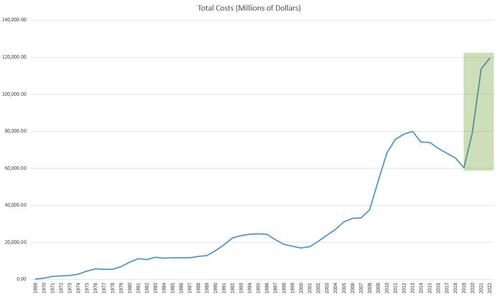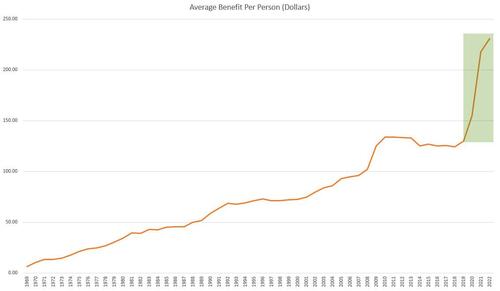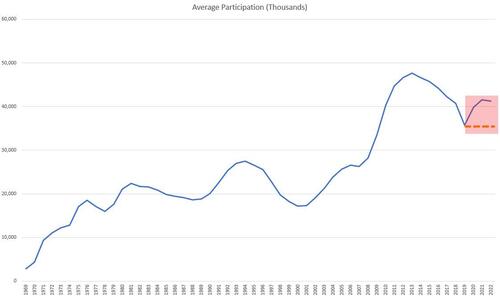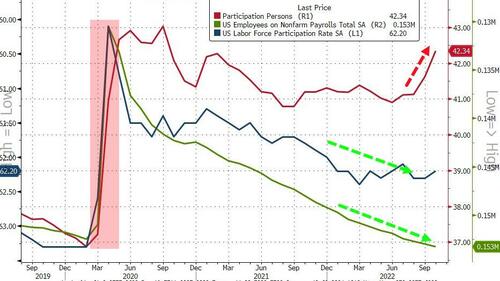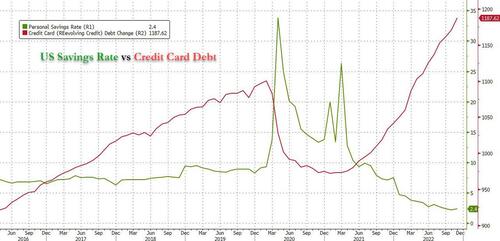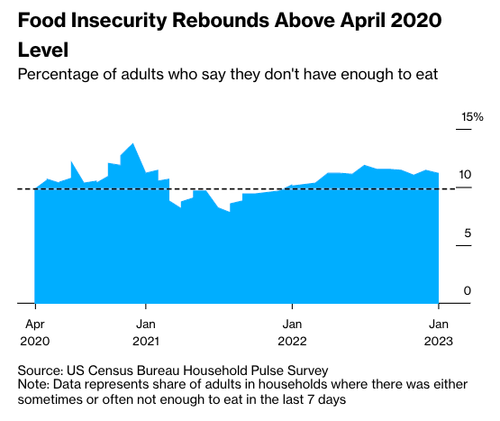
Enhanced benefits for the Supplemental Nutrition Assistance Program (SNAP) are set to expire at the end of February. The reduction in food stamps will impact more than 30 million Americans in 32 states -- many of these folks will face a "hunger cliff."
Bloomberg reported that once the enhanced benefits expire, families will receive at least $95 less per month. Some families could have a reduction of up to $250 per month.
Households with children will, on average, lose about $223 per month, according to the Center on Budget and Policy Priorities, a nonpartisan research and policy institute.
"Right now, people are really up against it."
"There's not a lot of cushions to absorb this," said Ellen Vollinger, SNAP director at the Food Research & Action Center, an anti-hunger advocacy group.
Bloomberg mapped out the 32 states where enhanced benefits are ending.
Recall that SNAP costs soared to a record $119.5 billion in 2022, according to data released by the USDA.
Food stamp costs have erupted from $60.3 billion in 2019, one year before the pandemic, to a record-setting $119.5 billion in 2022.
In 2019, the average monthly per-person benefit was $129.83 in 2019, according to the USDA. That increased by 78% to $230.88 in 2022.
Even more intriguing is that the number of participants increased from 35.7 million in 2019 to 41.2 million in 2022...
And the increasing number of SNAP participants comes at a time when the Biden administration declared the best jobs market ever.
What's on the chopping block is part of the Biden administration's welfare state. And many of these people who will see a reduction in benefits starting next month will have to partially fend for themselves in the worst inflation storms in a generation. Meanwhile, many of these folks have limited to no personal savings, maxed-out credit cards, and no safety nets.
Vollinger has previously described the expiration of enhanced SNAP benefits as a "hunger cliff" and described the number of states set to cut food stamps as "stunning."
Food insecurity is set to rise even more.
Perhaps the free ride is over for some SNAP recipients who might have to re-enter the labor market and find a job to cover expenses since the welfare state won't be as generous as it once was. More people searching for work might raise the labor force participation rate and, in return, increase the unemployment rate -- something the Federal Reserve desperately needs to cool off the red-hot jobs market.
Enhanced benefits for the Supplemental Nutrition Assistance Program (SNAP) are set to expire at the end of February. The reduction in food stamps will impact more than 30 million Americans in 32 states — many of these folks will face a “hunger cliff.”
Bloomberg reported that once the enhanced benefits expire, families will receive at least $95 less per month. Some families could have a reduction of up to $250 per month.
Households with children will, on average, lose about $223 per month, according to the Center on Budget and Policy Priorities, a nonpartisan research and policy institute.
“Right now, people are really up against it.”
“There’s not a lot of cushions to absorb this,” said Ellen Vollinger, SNAP director at the Food Research & Action Center, an anti-hunger advocacy group.
Bloomberg mapped out the 32 states where enhanced benefits are ending.
Recall that SNAP costs soared to a record $119.5 billion in 2022, according to data released by the USDA.
Food stamp costs have erupted from $60.3 billion in 2019, one year before the pandemic, to a record-setting $119.5 billion in 2022.
In 2019, the average monthly per-person benefit was $129.83 in 2019, according to the USDA. That increased by 78% to $230.88 in 2022.
Even more intriguing is that the number of participants increased from 35.7 million in 2019 to 41.2 million in 2022…
And the increasing number of SNAP participants comes at a time when the Biden administration declared the best jobs market ever.
What’s on the chopping block is part of the Biden administration’s welfare state. And many of these people who will see a reduction in benefits starting next month will have to partially fend for themselves in the worst inflation storms in a generation. Meanwhile, many of these folks have limited to no personal savings, maxed-out credit cards, and no safety nets.
Vollinger has previously described the expiration of enhanced SNAP benefits as a “hunger cliff” and described the number of states set to cut food stamps as “stunning.”
Food insecurity is set to rise even more.
Perhaps the free ride is over for some SNAP recipients who might have to re-enter the labor market and find a job to cover expenses since the welfare state won’t be as generous as it once was. More people searching for work might raise the labor force participation rate and, in return, increase the unemployment rate — something the Federal Reserve desperately needs to cool off the red-hot jobs market.
Loading…
